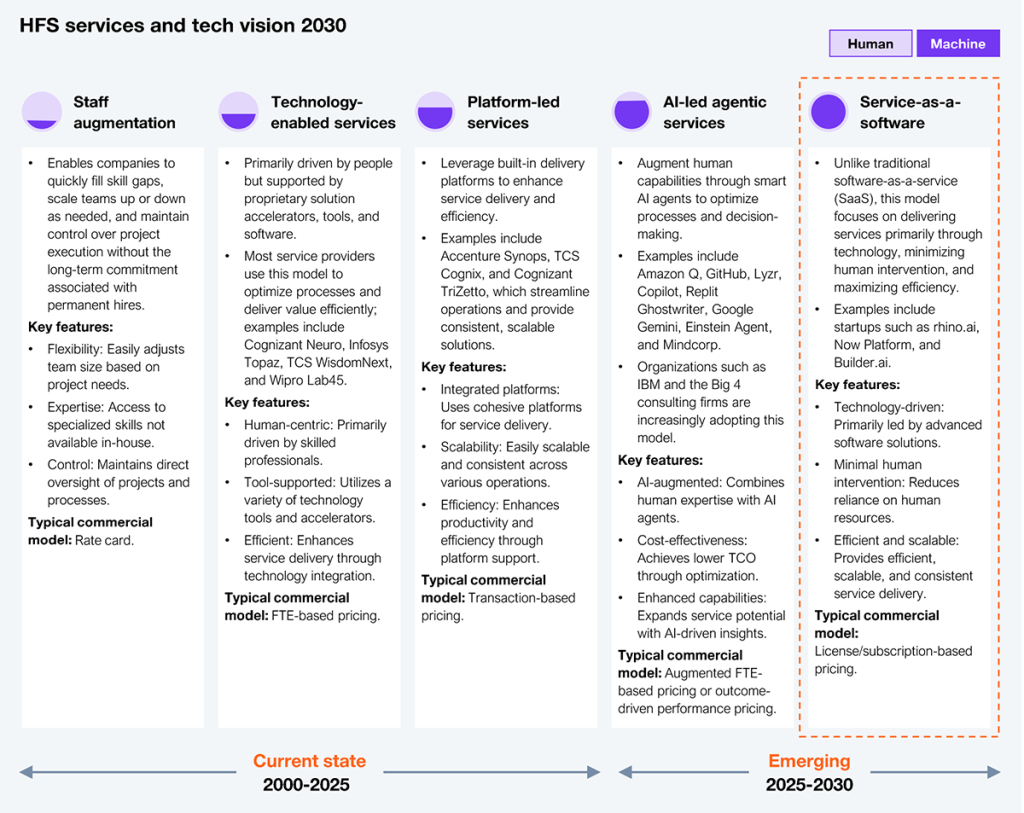Trade wars used to be fought with ships and embargoes. Today, they’re waged with tariffs, regulatory chokeholds, and digital sovereignty laws. The US and China have been throwing economic punches for years. Europe has fortified its own walled garden with GDPR and AI regulations, and the new US administration has intensified trade tensions with Canada and Mexico. However, amid the geopolitical chaos, CEOs and CIOs see a huge opportunity to rise above the noise and exploit the rapid advances in AI and automation technology (Services-as-Software) to ensure their organizations remain competitive.
As a CIO, you must prepare for the impact: rising costs for offshore/nearshore talent, imminent price hikes on technology hardware and software, delayed hardware shipments, and service providers suddenly subjected to new regulatory constraints. But protectionism isn’t just disrupting your current vendor relationships—it’s fundamentally transforming how services will be delivered to your organization.
The more governments try to lock down supply chains, labor markets, and data flows, service providers are left with no choice but to accelerate their shift toward Services-as-Software (SaS). By automating and digitizing service delivery, they’re reducing their reliance on people, physical goods, and traditional offshoring models, and this will change how you consume and integrate professional services across your organization. Savvy service providers will shift the delivery of software-based services to the US (or whatever location avoids financial penalties) to give their clients services unencumbered by government interference.
Governments pushing protectionist policies are stuck in a pre-World War II old-world paradigm, where economic strength comes from manufacturing dominance and self-sufficiency. The problem is that’s not how the world works anymore, where the internet has connected the world’s supply chains and commercial constructs to such an extent that it’s impossible to put the genie back in the bottle. Today’s industries thrive on interdependence and connectedness, yet leaders are doubling down on a model that no longer fits, as elaborated below:
Protectionism isn’t making industries stronger—it’s forcing them to become leaner, smarter, and less reliant on national economies, accelerating the shift to software-driven, automated service models.
When governments raise trade barriers, service providers don’t wait for a diplomatic resolution—they adapt. Increasingly, the adaptation strategy is Services-as-Software—the shift from human-dependent services to fully automated, software-driven solutions (See Exhibit 1).

Source: HFS Research, 2025
We’ve seen this playbook before. The first industrial revolution mechanized labor, the second optimized mass production, and the third digitized processes. Now, we’re in the next phase—the automation of services, where routine work that once required people, physical goods, and often cross-border transactions is being rewritten as code. Professional IT and business services companies such as Infosys, IBM, Genpact, Cognizant, KPMG, and Accenture are already repositioning their strategies to align with this vision.
But this SaS shift isn’t just about avoiding tariffs or dodging supply chain constraints—it’s transforming how value is created and delivered. All these protectionist policies are doing is accelerating the development of SaS because of the following:
The old playbook—offshoring to low-cost regions—is likely being replaced with software-first service delivery. The big question is whether the human element of services remains offshore or if the cost benefits encourage services to move onshore or be eliminated. CIOs must rethink their vendor relationships because how they buy and integrate services are fundamentally changing. They need partners aligned with their needs to support their transformation path to SaS.
When electric and hybrid vehicles entered mainstream consumer markets, dealerships needed to retrain their staff to understand how to sell and maintain hybrid and pure electric vehicles in addition to traditional gas vehicles. The same is happening with SaS models entering the enterprise equation. CIOs should adapt their knowledge and skills to program work types into software applications, work with their C-Suite counterparts to drive the process, and support the significant change management aspects involved. It’s one thing to move work from onshore people to offshore people. It’s an entirely different proposition to move work from people to computers.
CIOs should understand the implications for their operations, technology strategies, and vendor relationships:
CIOs should take proactive steps to get ahead of the shift:
Let’s be clear: while Services-as-Software may provide an escape hatch from protectionism, it doesn’t eliminate the need for interconnected ecosystems or people. AI and automation might replace some people, physical assets, and manual workflows, but they can’t substitute collaboration, shared data, and platform interoperability. No company operates in a vacuum, and no tech stack functions without dependencies.
CIOs can’t afford to treat protectionism as just a policy shift—it’s fundamentally reshaping how services are delivered and consumed. The move toward Services-as-Software is accelerating, forcing enterprises to rethink vendor relationships, integration strategies, and governance models.
Register now for immediate access of HFS' research, data and forward looking trends.
Get StartedIf you don't have an account, Register here |
Register now for immediate access of HFS' research, data and forward looking trends.
Get Started